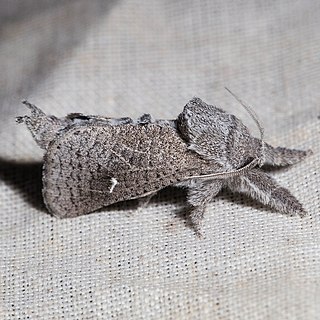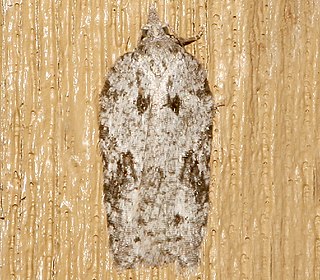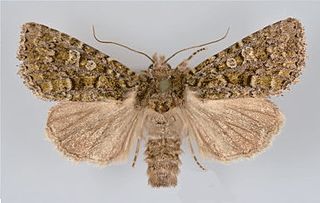
Boloria chariclea, the Arctic fritillary or purplish fritillary, is a butterfly of the family Nymphalidae. It is found in the northern parts of the Palearctic and Nearctic realms.
Tetracis hirsutaria is a moth of the family Geometridae first described by William Barnes and James Halliday McDunnough in 1913. It is found in the United States in California and extreme southern Nevada.
Hellinsia unicolor is a moth of the family Pterophoridae described by William Barnes and James Halliday McDunnough in 1913. It is found in North America, including Florida, Mississippi, Georgia and Kentucky.

Iridopsis clivinaria, the mountain mahogany looper moth, is a moth of the family Geometridae. It is found from British Columbia south to California and east to Idaho, Colorado and Arizona.

Cahela is a monotypic snout moth genus described by Carl Heinrich in 1939. Its only species, Cahela ponderosella, the cahela moth, described by William Barnes and James Halliday McDunnough in 1918, is found in Mexico and in the US states of California, Texas, Arizona, Utah and probably Nevada.

Properigea albimacula is a small to medium-sized moth in the family Noctuidae first described by William Barnes and James Halliday McDunnough in 1912. It is found in the western US on the slopes of Cascades north of Oregon and almost throughout California. The wingspan is about 15 mm. Adults fly during the summer and are most common during July. This species is nocturnal and comes to lights.

Givira marga is a moth in the family Cossidae first described by William Barnes and James Halliday McDunnough in 1910. It is found in North America, where it has been recorded from California and Arizona.

Givira minuta is a moth in the family Cossidae first described by William Barnes and James Halliday McDunnough in 1910. It is found in North America, where it has been recorded from southern Arizona.

Protorthodes rufula, the rufous Quaker moth, is a moth in the family Noctuidae. The species was first described by Augustus Radcliffe Grote in 1874. It is found in western North America along the Pacific Coast, and the coastal mountain ranges from northern Washington to southern California.
Evergestis subterminalis is a moth in the family Crambidae. It was described by William Barnes and James Halliday McDunnough in 1914. It is found in western North America, where it has been recorded from west central Alberta south to Colorado, Utah and California. The habitat consists of montane meadows.
Acleris nigrolinea is a species of moth of the family Tortricidae. It is found in North America, where it has been recorded from Alberta, Arizona, British Columbia, California, Colorado, Indiana, Maine, Manitoba, Maryland, Michigan, Minnesota, New Brunswick, New Hampshire, North Carolina, Ontario, Pennsylvania, Quebec, Tennessee, West Virginia and Wisconsin.

Acleris maximana is a species of moth of the family Tortricidae first described by William Barnes and August Busck in 1920. It is found in North America, where it has been recorded from Alberta, British Columbia, California, Maryland, Massachusetts, Montana, New Brunswick, North Carolina, Ontario, Pennsylvania, Saskatchewan, Tennessee, Utah and Washington.

Acleris caliginosana is a species of moth of the family Tortricidae. It is found in North America, where it has been recorded from Alberta, British Columbia, California, Colorado, Idaho, Maine, Montana, New Brunswick, Nova Scotia, Ontario, Quebec, Washington and Wisconsin.

Dasychira vagans, the variable tussock moth, is a moth of the family Erebidae. It is found in North America, where it has been recorded from Newfoundland to southern British Columbia in the north and North Carolina and Utah in the west. The habitat consists of forests, including coastal rainforests, high elevation mixed hardwood-conifer forests, oak woodlands and mixed hardwood forests. The species was first described by William Barnes and James Halliday McDunnough in 1913.

Epiglaea decliva, the sloping sallow moth, is a moth of the family Noctuidae. It is found in North America, where it has been recorded from Quebec and Maine to South Carolina, west to Kansas and north to Alberta. The habitat consists of barrens, thickets, woodlots and forests.

Ceranemota is a genus of moths belonging to the subfamily Thyatirinae of the Drepanidae.

Ceranemota improvisa is a moth in the family Drepanidae. It was described by Henry Edwards in 1873. It is found in North America, where it has been recorded from northern California, western Oregon, western Washington and south-western British Columbia. Adults are on wing from late September to November in one generation per year.

Ceranemota crumbi is a moth in the family Drepanidae. It was described by Foster Hendrickson Benjamin in 1938. It is found in North America, where it has been recorded from western Oregon and the Washington Cascade Range. The habitat consists of coastal rainforests and mixed hardwood forests.

Ceranemota tearlei is a moth in the family Drepanidae. It was described by Henry Edwards in 1888. It is found in North America, where it has been recorded from British Columbia and central Alberta south to central California in the west and to Utah and Colorado in the Rocky Mountains. The habitat consists of higher elevation spruce-fir and mixed hardwood-conifer forests, lower elevation ponderosa pine forests, quaking aspen forests and moist riparian areas along creeks and rivers.

Viridiseptis is a monotypic moth genus in the family Noctuidae erected by Tomas Mustelin and Lars G. Crabo in 2015. Its only species, Viridiseptis marina, was first described by Augustus Radcliffe Grote in 1874. It is found throughout coastal California and in south-western Oregon as far north as Douglas County. It is widely distributed in southern California. It is found in many habitats such as coastal chaparral, mountain forest, mountain-desert transition zone, and occasionally in the deserts from sea level to at least 2000 meters.














